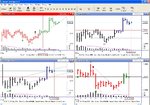VSA Trader,
When I read your original post, a few weeks ago, I thought that it was nonsense, having seen markets move in the opposite direction to the bid or ask volume traded.
This point of view evolved based on volumes that were reported via my data feed. I have an account with IB, which enables me to receive real time data for, effectively, nothing. I have never doubted their ability to accurately report, not only price but, volume of contracts traded at that price and specified time. I accepted, without question, that all the data they transmitted was accurate.
Last Friday, I had reason to speak with a contact who receives data from two of the major real time data feed companies. He uses volume as an integral part of his trading set ups. I was shocked to learn that, although their reported volumes were almost identical, my IB volume was totally out of sync with them. We compared our data over several 5 minute bars. On one bar, in particular, there were 800+ contracts traded but, according to IB, there were 6,500. It looks as though they are accumulating their volumes and then pushing them through in chunks.
From today, I will start a week's free trial with one of the independent data vendors as I would like to incorporate volume into the process of making my day trading decisions.
My apologies for rubbishing your earlier post.
rgds
Alan


